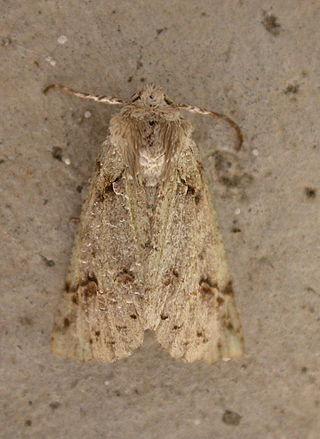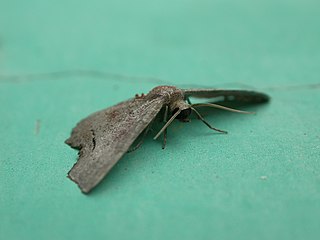Related Research Articles
Sir George Francis Hampson, 10th Baronet was an English entomologist.

Nepticulidae is a family of very small moths with a worldwide distribution. They are characterised by eyecaps over the eyes. These pigmy moths or midget moths, as they are commonly known, include the smallest of all living moths, with a wingspan that can be as little as 3 mm in the case of the European pigmy sorrel moth, but more usually 3.5–10 mm. The wings of adult moths are narrow and lanceolate, sometimes with metallic markings, and with the venation very simplified compared to most other moths.

Urodidae, whose species are commonly known as false burnet moths, is a family of moths in the lepidopteran order. It is the type genus in the superfamily, Urodoidea, with three genera, one of which, Wockia, occurs in Europe.

Heliodinidae, commonly known as sun moths, is a family of small moths with slender bodies and narrow wings. Members of this family are found in most parts of the world. Heliodinid moths are brightly coloured day-flying moths. The base of the haustellum is bare. The scales on the head are compact and appear like a shield. Many Heliodinidae raise their hindlegs when resting but this is not a taxonomic feature and several genera like Epicroesa and Lamprolophus do not show this posture. Many Heliodinidae have the inner and outer spurs of the metatibia subequal. The larval host plants of the majority of species are in the Aizoaceae, Chenopodiaceae, Phytolaccaceae, Portulacaceae and Nyctaginaceae, all in the Order Caryophyllales. A few feed on Onagraceae, Araliaceae and Piperaceae. The pupae have long stiff hairs on their back sides.
Metachanda is the sole genus in tribe Metachandini of moth subfamily Oecophorinae. Metachandini was originally described as family Metachandidae by Edward Meyrick in 1911, and at the time also contained the genus Chanystis, which is currently unplaced to tribe within Oecophorinae. It has also previously been described as tribe Metachandini of subfamily Gelechiinae.
Agathiphaga is a genus of moths, known as kauri moths. and is the only living genus in the family Agathiphagidae. This caddisfly-like lineage of primitive moths was first reported by Lionel Jack Dumbleton in 1952, as a new genus of Micropterigidae.
Evita is a monotypic moth genus in the family Geometridae described by Hahn William Capps in 1943. Its only species, Evita hyalinaria, was first described by Grossbeck in 1908. It is found in southwestern North America.

The Thyatirinae, or false owlet moths, are a subfamily of the moth family Drepanidae with about 200 species described. Until recently, most classifications treated this group as a separate family called Thyatiridae.
Zebeeba is a monotypic moth genus in the family Erebidae erected by William Forsell Kirby in 1892. Its only species, Zebeeba falsalis, was first described by Gottlieb August Wilhelm Herrich-Schäffer in 1839. It is found in northern Africa, southern Europe, Asia Minor and the Levant.
Mylantria is a monotypic moth genus in the subfamily Lymantriinae erected by Per Olof Christopher Aurivillius in 1904. Its only species, Mylantria xanthospila, was first described by Plötz in 1880. It is found in western Africa.
Celonoptera is a monotypic moth genus in the family Geometridae. Its only species, Celonoptera mirificaria, is found in south-eastern Europe. Both the genus and species were first described by Julius Lederer in 1862.

Declana is a genus of moths in the family Geometridae that is endemic to New Zealand. The genus was erected by Francis Walker in 1858.
Plegapteryx is a genus of moths in the family Geometridae erected by Gottlieb August Wilhelm Herrich-Schäffer in 1856.

Xenozancla is a monotypic moth genus in the family Geometridae. Its only species, Xenozancla versicolor, is found in northern India. Both the genus and species were first described by William Warren in 1893.

Pasma tasmanicus, the two spotted grass skipper, is the only species in the monotypic butterfly genus Pasma of the family Hesperiidae. The genus was erected by Gustavus Athol Waterhouse in 1932. The species was first described by William Henry Miskin in 1889. It is found in the Australian states of New South Wales, South Australia, Tasmania and Victoria.

Cyme sexualis is a moth of the subfamily Arctiinae first described by Felder in 1864. It is found on Ambon, Sulawesi, the Dampier Archipelago. and in New Guinea.
Groenendaelia is a monotypic moth genus in the family Cossidae. Its only species, Groenendaelia kinabaluensis, is found in Sundaland, including Borneo. The habitat consists of montane forests and lowland areas.
Aholcocerus ihleorum is a moth in the family Cossidae. It is found in Thailand.
Aholcocerus ronkayorum is a moth in the family Cossidae. It is found in Pakistan.
Aholcocerus sevastopuloi is a moth in the family Cossidae. It is found in India.
References
- ↑ Beccaloni, G.; Scoble, M.; Kitching, I.; Simonsen, T.; Robinson, G.; Pitkin, B.; Hine, A.; Lyal, C., eds. (2003). "Aholcocerus verbeeki". The Global Lepidoptera Names Index . Natural History Museum. Retrieved April 25, 2018.
- "Generic Names and their Type-species". Butterflies and Moths of the World. Natural History Museum. Retrieved April 14, 2016